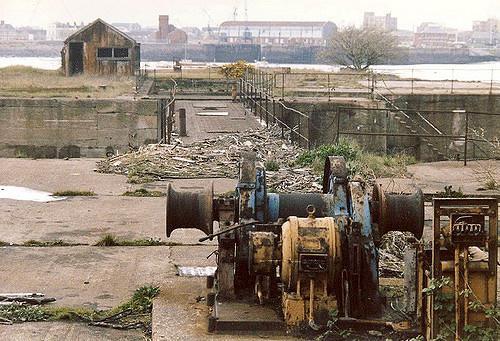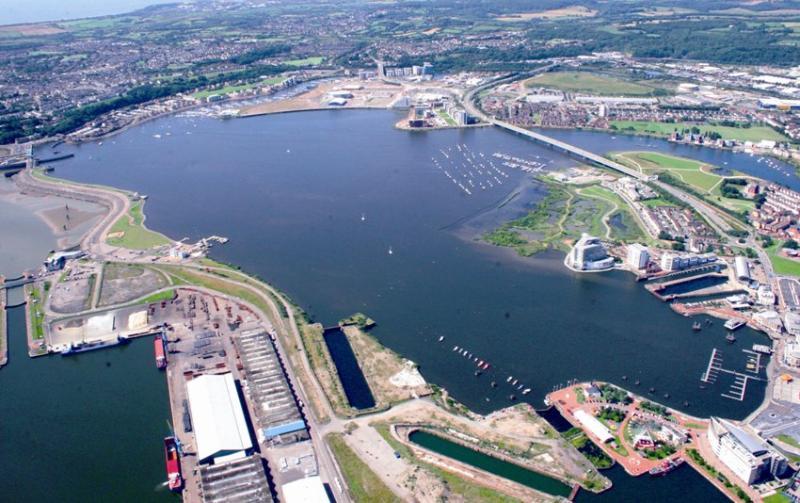The UK remade industrial inner cities in the 1980s as vibrant urban centres—a strategy that has been taken up all over Europe
Amid the splendour of Michelangelo’s architectural innovations at the Palazzo dei Conservatori on the Capitoline Hill, delegates from six European countries signed the Treaty of Rome on 25 March 1957. The treaty, which included the articles that founded the European Investment Bank, was “a declaration of future good intentions,” according to one historian. For two weeks, we are publishing a series of stories to mark the sixtieth anniversary of the treaty—one for each decade of the EIB story. These are stories of how the EIB helped turn good intentions into reality.
Download the book, available in PDF and epub format.
After rugby matches in the 1970s, fans would spill out of the stadium at Cardiff Arms Park, heading toward the docks to drink in the pubs of the Welsh capital’s red light district in Tiger Bay. The area got its name in the heyday of the city as a port for coal exports, when it was known for the rough and sometimes murderous exploits of sailors on shore leave. By the 1980s, the exports had ended with the closure of the nearby mining industry. Only the rough reputation remained. Retired architect David Poole recalls working on a renovation project near the docks at that time. He and a colleague had climbed a scaffold to examine a building. Looking down, they saw a young boy ride his bicycle down the street carrying a brick. The boy threw the brick through the window of Poole’s car and leaned in to steal his bag. Suddenly another boy arrived, mugging the thief and taking the bag in his turn. “It really was a rough spot,” says Poole. “It had got pretty bad down there.”
But in the late 1980s Cardiff’s docks were the focus of a major urban regeneration project. A barrier built across the bay turned the convergence of the Rivers Taff and Ely into a lagoon around which public buildings, arts and entertainment centres, and restaurants were built. The EIB contributed to the development with financing for a congress centre, a hotel, and an office building. Now Cardiff Bay is a major tourist attraction and a vibrant focus for city life that has also significantly boosted the economy of the rest of the city. Each Friday Poole and former colleagues from the regeneration work Padrig Davies and David Rees meet at a French restaurant named Côte by the bay and marvel at the change over the decades. “This has made a hell of a difference to Cardiff,” says Rees. “The whole city is transformed, and it started here in the docks.”

An urban focus
The decline of heavy, export industries all across the UK in the previous decade made the 1980s a time of change in the country’s docks. The EIB funded projects in London’s Canary Wharf as well as in regional centres like Cardiff. Previously, urban finance had been largely ancillary to other Bank loans that simply happened to be in cities. Gradually, the Bank developed a growing urban focus, alongside changes in EU policy at the 1999 Amsterdam Summit. Now, with the Pact of Amsterdam in 2016, the EIB has a prominent role in the EU Urban Agenda, with its financing and advisory services for urban development specifically referred to in the pact itself.
There are compelling reasons why towns and cities have become so much the focus of EIB activity. In 2008, more than 50% of the world’s population lived in urban settlements. By 2030, that will have risen to 60% and will be equivalent to the total global population in 1987, when Cardiff was getting its makeover. With the growth in cities, there’s also an increase in their impact on the environment. As major centres for the transformation of primary resources and goods, cities are the most important engines of economic growth. They’re also the most significant source of contamination, pollution and waste. Cities are good for economic progress, but they also pose a threat, unless the pace and patterns of urbanisation are channelled appropriately. For example, given current rates of urbanisation, cities will account for an increasingly large proportion (already at more than 70%) of global energy use and CO2 emissions. The inevitable and significant impact on global warming provides an obvious rationale for focusing on cities in energy management, climate change mitigation and adaptation.

From Barcelona to Eastern Europe
Brian Field worked as a special managerial advisor on urban planning and development at the EIB for many years before becoming a professor at University College, London. In an earlier academic incarnation during the 1970s, he used to take his students to Cardiff Bay to study a perfect case of urban blight. He traces a trajectory of EIB urban lending from Cardiff and other 1980s projects through social housing schemes in Glasgow during the late 1990s and on to the London Olympics, where the Bank financed the athletes’ village on the basis that it would subsequently become a social housing legacy project in the Stratford neighbourhood. “Cardiff’s regeneration has been spectacular,” says Field. “The Bank has had a similar effect across a very wide range of cities—you need only look at the transformation of Barcelona, and then on into EIB-financed urban regeneration initiatives in Eastern and Central Europe.”
Under the Treaty on European Union, the EU has formal responsibility for Regional Policy whilst Urban Policy is under the jurisdiction of the Member States, either at national or local level (regions, cities, towns). However, the EU’s promotion of employment, growth, and quality of life, also requires a concerted effort at the local level and, against this backdrop, the regional and specifically the urban context has become a key area of concern and focus for public policy. The urban dimension is incorporated at EU level through Cohesion Policy. The notion of its importance has grown gradually.
The Bank’s urban lending got a major boost during the years in which Central and Eastern European countries joined the EU. Gerry Muscat, head of the urban development division, worked in Eastern Europe for another international organisation at that time and saw how the dismantling of centrally planned economies there led to increased opportunities for municipalities and regions to manage their own development. “Suddenly they had their own sources of revenue and they could invest as cities,” says Muscat. “It empowered them to think about urban development for themselves.”
The EU Urban Agenda defines a set of key priorities which resonate across European cities:
- Smart Cities: European cities should become low carbon, low waste and smart flow cities. This involves the efficient management of resources (especially with respect to energy and transport) based on smart infrastructure solutions. Examples include supporting sustainable urban mobility and accessibility, energy efficiency and use of renewable energies, and building on the digital agenda.
- Green Cities: European cities should become environmentally friendly, climate resilient and compact. This embeds urban development in green infrastructure and nature-based solutions. Examples include building short circuit food production, minimising urban sprawl, land-take and soil sealing, as well as improved conservation of natural habitats.
- Inclusive Cities: European cities should become living, caring, inter-generational cities. This includes improving the quality of life through developing affordable housing, regenerating deprived neighbourhoods, improving access to key urban services, developing the local economy and creating jobs.
Muscat, the urban development head, puts it more starkly as the EIB heads toward its seventh decade. “The challenges of Europe are in many ways urban challenges,” he says. “Climate change, refugees, radicalisation and terrorist threats, social inequity. Urban development is a major part of the solution, because it builds social infrastructure and fosters job creation.”
